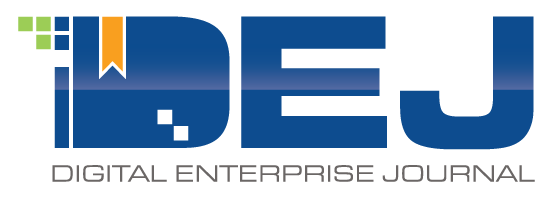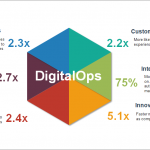This Research Note is an overview of key briefings that DEJ conducted with technology vendors in April of 2020. The article analyzes vendors’ announcements, market position and an alignment with key findings of DEJ’s research.
On April 16, Anodot announced that it secured $35 million in Series C funding. Anodot has been one of the leading companies when it comes to alignment with DEJ’s research findings and key user requirements and the company was listed in DEJ’s 2019 “Top 20 Vendors for Enabling Best Performing Organizations in Managing IT Operations” report, receiving the highest scores in all six evaluation categories. The company’s technology, based on a unique approach for anomaly detection, is applicable to a wide range of use cases, but where it provides the most value is in the area where that has become the #1 requirement for user organizations – leveraging technology, IT and user data to provide actionable insights into business performance.
Figure 1 shows six areas where business executives are looking for IT solutions to improve and Anodot is addressing each of these areas in a unique fashion. The company’s solution is focusing on three key areas of business monitoring: 1) revenue and cost; 2) partner ecosystem; and 3) user experience. For each of these business areas, Anodot’s solution allows organizations to leverage monitoring data that is: 1) actionable; 2) proactive; 3) timely; and 4) relevant.
Figure 1
DEJ’s recent study on the state of IT performance revealed 19 key areas that are shaping this market and Anodot is one of a few vendors in the market that can effectively address most of these areas. Also, 60% of organizations that participated in the study reported the impact on business outcomes as the key criteria for selecting IT performance management solutions (a 75% increase over the last 2 years). As the power in the IT performance markets is shifting towards the vendors that can provide clear business value, Anodot is in a very good position to capitalize on this trend.
Centerity is one of the vendors that is best aligned with user requirements for AIOps solutions, based on findings of DEJ’s new study, “Strategies of Top Performing Organizations in Deploying AIOps”. The study shows that there is no significant difference between top performing organizations (TPOs – top 20% of research participants based on their performance) and all others when it comes to adopting AIOps functions such as data ingestion, enrichment, correlation and suppression. However, the TPOs are 2 times more likely to adopt AIOps functions for identifying the impact of IT performance on business outcomes. That is one of the core strengths and differentiators of Centerity’s platform as it provides a wide coverage of technology environments (security, application and network performance, IoT, etc.) and translates it into health of business services. This capability, on a high level, is not unique to Centerity, but the company’s engine for analyzing the data provides a unique combination of capabilities such as real-time analysis, ability to predict performance levels, service level deep views and a unique approach for creating a service tree mapping.
Centerity’s platform is also well positioned to address a number of key challenges that are being reported in DEJ’s research: 1) lack of end-to-end visibility (58% of survey respondents); 2) inability to prevent performance issues before users are impacted (64%); and 3) time spent on identifying the root cause of performance issues (61%). The unique combination of delivering IT data in a business context, ability to provide actionable insights across IT domains and effectiveness in dynamic and hybrid environments positions Centerity as one of the top vendors in the AIOps space.
DEJ’s research is showing three major trends for managing IT performance in production: 1) monitoring solutions that were built for addressing performance issues that were prominent 5-10 years ago are not being as effective in managing new dynamic environments; 2) responsibilities for production performance are increasingly shifting to DevOps and SREs; 3) the concept of Observability is gaining a lot of interest as its value proposition is well aligned with most of the key management challenges. Epsagon is well positioned to capitalize on all of these trends and the company’s solution provides very strong capabilities in many of the key areas, especially for managing microservices and Serverless environments.
Sixty percent of organizations in DEJ’s research reported that having a unified view into their dynamic environments is the key capability for IT performance management. Epsagon’s agentless solution provides end-to-end view into performance of applications and microservices. The company’s technology includes several value points that are becoming increasingly important in managing these environments such as strong automation and tracing capabilities and data correlation and analysis. Also, 54% of organizations in DEJ’s recent research listed time to value as a top selection criteria for evaluating IT performance solutions and this is one of Epsagon’s key strengths.
Epsagon is one of the companies that built a solution for addressing emerging issues and these issues are emerging fast. DEJ’s upcoming study on Enabling Top Performing Engineering Teams shows that 37% of organizations are deploying, or looking to deploy, Serverless over the next 12 months. As the market is “coming to them”, Epsagon is well positioned to capitalize on these opportunities and take the next step in the company’s growth.
Findings of DEJ’s upcoming study show that 65% of engineers (out of these that are familiar with this concept) see the value in implementing Observability in their organizations. This concept is still not well defined and the market needs more education about what Observability really means, but preliminary findings of DEJ’s upcoming study on The Value of Observability show 4 key areas where organizations are showing the most interest in deploying Observability solutions: 1) making more educated decisions faster; 2) facilitating innovation by adding more intelligence to software release cycles; 3) providing full visibility across complex environments at scale; 4) maximizing the value of Cloud deployments. Humio’s solution addresses each of these four areas in a unique fashion.
Humio’s solution is able to ingest the data at sub-second latency, scale up to 100’s of TB per day and still allows organizations to have a very short time-to-insight. The key enabler of these capabilities is the company’s in-house built database that allows organizations to perform index-free search and find information that they need very quickly.
Also, one of the key Humio’s value points is high scalability of the company’s solution provided at a cost that is significantly lower than that of most of log management and analytics solutions in the market.
Humio’s solution can address the variety of use cases and its combination of cost and scale should be a no brainer for organizations that are comparing the Humio to more traditional log management tools. However, the company’s ability to provide timely and actionable insights can be a “golden ticket” that can take Humio’s growth to a new level and position the company as a leader in the Observability space.
DEJ’s Research Note, “Digital Experience Monitoring – the Main Scoreboard for IT Transformation” shows that the customer experience is the only real measure of IT departments’ success in the digital economy. From the technology perspective, the DEM is consisted of multiple sub-markets that include monitoring from inside and outside of firewall, synthetic and real user monitoring, monitoring from a browser, user device, etc. Login VSI takes a completely unique approach for ensuring optimal performance of IT services as measured from the end-user perspective. The company’s solution leverages the network of more than 600,000 synthetic virtual users that emulate real-user sessions, application usage, logins, etc. This approach allows organizations to close the monitoring gap between the IT and the business users while eliminating some shortcomings of traditional DEM solutions, both from visibility and management perspectives.
DEJ’s recent study, “13 Key Trends Transforming the IT in 2020”, shows a 2.7 times increase in new technology deployments since 2016, while 68% of organizations reported increased customer expectations for engagement and experience. As the velocity and pace of change in IT environments is continuously increasing and insuring optimal user experience is becoming more challenging, taking a proactive approach for managing application performance is becoming critically important. DEJ’s 2019 study, “The Roadmap to Becoming a Top Performing Organization in Managing IT Operations”, shows that TPOs are experiencing a 79% success rate in preventing performance issues before users are impacted, as compared to 39% for all others. As a result, TPO have 96% more IT resources available for innovation and growth.
Login VSI’s unique approach for managing the quality of user experience is well aligned with key requirements for managing modern, fast-changing IT environments. More importantly, DEJ’s research shows that there is a strong correlation between Login VSI’s value proposition and key business goals that organizations are looking to achieve.
NetBrain is automating processes in two key areas of network management: 1) preventing and resolving performance issues; 2) documenting network and processes. The company’s solution supports each of the key stages in incident response in a unique fashion. DEJ’s AIOps study shows that organizations are spending $1,270,000, annually, on incident escalations that could be avoided. NetBrain’s solution allows organizations to eliminate this cost by reducing time wasted, manual tasks and collaboration efficiencies in earlier stages of the incident response lifecycle. Additionally, NetBrain provides strong capabilities for remediation and post-mortem analysis. One of the unique capabilities of NetBrain’s solution is the ability to automate the process for incorporating lessons learned in a post-mortem analysis into entire incident response cycle. This improves organization’s ability to proactively prevent performance problems and enables continuous learning and improvement.
Fifty-seven percent of organizations in DEJ’s recent research reported that managing network performance became more difficult after deploying cloud services while 53% experienced decline in network visibility after deploying SDN or SD-WAN. NetBrain’s solution is agnostic of a type of network environment and allows organizations to create dynamic interactive network maps in an automated fashion, coupled with an automated runbook. This helps organizations to be more effective in dealing with ongoing changes in their network environments and significantly reduce time needed to identify and resolve performance issues.
Fifty-nine percent of organizations in DEJ’s recent research described the importance of automation for network management as “High” or “Very High”. NetBrain is one leader in the emerging area of network automation and the value of the company’s solution is already very strong for IT and network practitioners. However, NetBrain’s value proposition could also resonate very well with IT executives and LoB owners, especially in the areas of eliminating cost of incident response and automating proactive management.
This was an update briefing with Rafay and the progress that the company made over the last 9 months is impressive. The company provides a management and governance platform for Kubernetes multi-clusters. The platform is agnostic of where microservices are deployed and could be used across data centers, cloud and the Edge.
Sixty-two percent of organizations in DEJ’s recent research reported that acquiring and retaining top talent is one of the key challenges for managing microservices. Additionally, 76% of organizations reported that their number of operational clusters increased over the last 12 months. These are two of the key value areas for Rafay, as the company provides a single pane of glass platform for managing all the clusters. Additionally, Rafay’s solution is built for IT Operations so there is no learning curve for Kubernetes adoption.
Fifty-five percent of organizations in DEJ research reported that microservices are playing a key role in facilitating innovation and creating competitive advantage. Organizations are also becoming increasingly concerned about the complexity of managing microservices. Rafay’s key strength is addressing this challenge and enabling organizations to get full benefits of deploying microservices which has clear value for both LoB owners and IT practitioners.
DEJ’s research shows that organizations are losing $2,129,000 per month, on average, due to delays in applications releases that are performance related. Additionally, the research shows a 4.5x increase in the number of organizations making software a core part of their business strategy since 2017. Shipping better software to the market faster is becoming one the key sources of competitive advantage, but is also associated with a number of challenges. Rookout’s solution is designed to address these challenges from multiple angles.
68% of organizations in DEJ’s upcoming study on Enabling Top Performing Engineering Teams reported that they are experiencing a “flying blind or flying slow” type of challenge. In other words, they are facing a tradeoff to either ship software faster, but without the data that they need to ensure optimal performance, or to delay releases while trying to get the data. Rookout helps engineers to get the data that they need to write a better software instantly, without having to write a specific code to access this information. Also, the solution is agnostic of a type of environment where it can be used (Serverless, microservices, etc.) and it can be deployed for as many instances as needed.
Forty-seven percent of organizations in DEJ’s research reported that the amount of unplanned work is one of the key challenges for Engineering and Dev teams. Rookout’s capabilities for providing relevant and actionable data to improve code quality instantly have a major business value and the company is well positioned to address modern requirements for using technology as a source of competitive advantage.
The scope of the briefing was PagerDuty’s quarterly update for DEJ and it doesn’t come as a surprise that most of the news from PagerDuty were centered around listening to their customers and working to ensure that their needs are met during the COVID-19 crisis. Customer-centric culture has been a major part of the company’s strategy since its early days and putting customers first became even more of a focus during the pandemic, through both adding new technology capabilities focused on enabling remote work, but also educating user organizations about how to best cope with challenges of today.
Also, PagerDuty’s Digital Operations business unit continues to grow by impressive margins which is a result of two trends: 1) changes in user requirements and increased focus on a business-centric approach for IT performance management; 2) increasing importance of the company’s position in enabling real-time work. DEJ’s study on IT transformation shows that managing production performance is shifting left. Additionally, 36% of organizations are looking to modernize their IT Operations around DevOps principles. The concept around Digital Operations brings multiple teams together via a real-time, customer-centric platform and has them focused on key business outcomes.
PagerDuty has also seen a significant growth of users of their platform coming from customer service and security teams. This also doesn’t come as a surprise as 56% of organizations in DEJ’s recent study, “19 Key Areas Shaping IT Performance Markets in 2020”, described the importance of context-driven automation for managing service desk as “high” or “very high”.
DEJ’s AIOps study shows that the annual cost of “war room” meetings is $4,620,000. The market role of PagerDuty’s platform is becoming increasingly important (with or without a current situation in the world) as organizations are being pressured to identify areas where they can eliminate unnecessary cost while effectively supporting more remote users.
On April 14 Scalyr announced the ability to ingest and analyze more than 200 TB of data per day in real-time. Also, this capability is provided at a fraction of cost as compared to most of the similar solutions in the market. This announcement just added more to a lengthy list of the company’s strengths and differentiators in log management and Observability markets.
DEJ’s research shows a 76% increase in the number of organizations reporting that making IT performance data more actionable as their key goal, over the last 18 months. Additionally, the research shows an average 86% increase in the amount of change in IT environments since 2016. These trends play to some of Scalyr’s core strengths, as its solution keeps all the data active and it’s able to analyze it immediately as 96% of the company’s searches return in less than 1 second. This allows organizations to be effective in complex and fast changing environments and one the company’s core strengths is managing the performance of Cloud services and microservices. Additionally, the fact that Scalyr is able to process high-cardinality data and applies strong analytics capabilities allows organizations to put this data in actionable context and quickly find information needed to solve the problem.
DEJ’s research shows that impact on business outcomes and situational alignment (technology environment, use case, etc.) are the top two criteria for selecting IT performance management solutions. As a result, Scalyr is very well positioned for the future growth, as the company is making a clear impact on some of the key business outcomes (cost savings, driving innovation, customer satisfaction and engagement, etc.) while also being very effective in emerging dynamic IT environments (IoT, microservices, distributed computing, etc.).















